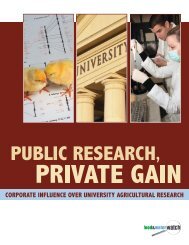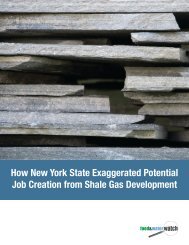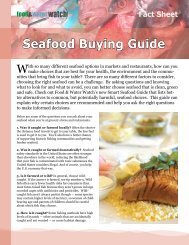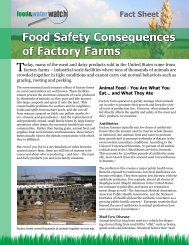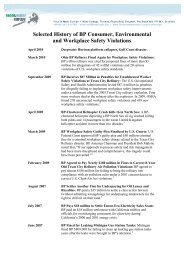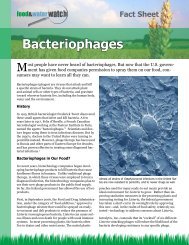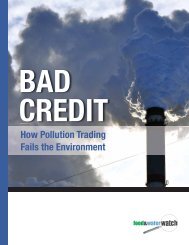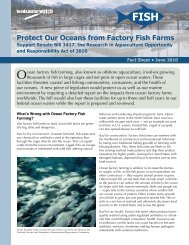Who's Benefitting from Factory Fish Farming? - Food & Water Watch
Who's Benefitting from Factory Fish Farming? - Food & Water Watch
Who's Benefitting from Factory Fish Farming? - Food & Water Watch
You also want an ePaper? Increase the reach of your titles
YUMPU automatically turns print PDFs into web optimized ePapers that Google loves.
INTERNATIONAL<br />
Who’s <strong>Benefitting</strong> <strong>from</strong><br />
<strong>Factory</strong> <strong>Fish</strong> <strong>Farming</strong>?<br />
Fact Sheet • September 2011<br />
Offshore aquaculture is factory fish farming of the sea, growing fish in huge,<br />
often over-crowded cages out in ocean waters. It can be problematic for both<br />
the environment and the economy. The waste – fecal matter, uneaten food, and any<br />
chemicals or drugs used in the operation – flows directly into the ocean, and the<br />
result could be long-term damage to the seafloor. 1 Despite its negative impacts, the<br />
following groups push for, or would profit <strong>from</strong>, factory fish farming in the United<br />
States and Europe.<br />
The Aquaculture Industry<br />
Extensive research shows that the escape of farmed fish<br />
into the wild can result in competition for food and<br />
space with native species.² In October 2009, for example,<br />
60,000 salmon escaped <strong>from</strong> a Lighthouse Caledonia<br />
facility in Argyll, Scotland – more than the total<br />
number of escapes the previous year – raising concerns<br />
about the spread of disease to threatened wild salmon<br />
populations. 3<br />
In the United States, a study at a Hawaiian aquaculture<br />
facility found that fish farm cages, even in deep ocean<br />
waters, had “grossly polluted” the sea floor and “severely<br />
depressed” marine life at some sampling sites very close<br />
to the fish cages. Over the course of 23 months, these<br />
effects had spread to sites up to 80 meters away. 4 Kona<br />
Blue <strong>Water</strong> Farms, an aquaculture company based in<br />
Hawai’i, has a questionable track record – <strong>from</strong> killing<br />
a 16-foot tiger shark in the fall of 2005, 5 to losing cages<br />
in the spring of 2011. 6 Hawai’i Oceanic Technology, a<br />
fish farm that has a lease to grow tuna in Hawaiian state<br />
waters, takes about 42 pounds of wild fish to create 10<br />
pounds of marine farmed fish. 7<br />
The Soy Industry<br />
The use of soy as a non-fish protein in aquaculture<br />
feeds is growing. This trend is due to research funding<br />
<strong>from</strong> various soybean industry groups. 8 Since 1995, the<br />
United Soybean Board has funded research to develop a<br />
market in farmed-raised fish; this program has increased<br />
soybean meal in fish feed <strong>from</strong> 0 to 5 million metric tons<br />
within ten years. 9 There are several U.S. soy industry<br />
groups that are members of a trade organization that<br />
advocates for open ocean aquaculture 10 and could stand<br />
to benefit <strong>from</strong> the increase in feed that factory fish farms<br />
would require. Europe is already over reliant on imported<br />
soy for its industrial livestock and poultry industries,<br />
and it should be moving away <strong>from</strong> its dependence on<br />
imported soy, not looking to increase demand for it with<br />
factory fish farming.<br />
The Copper Industry<br />
The nutrient-rich water surrounding factory fish farm<br />
cages enhances the growth of algae and other organisms,<br />
together called bio-foulants. 11 Copper is used in aquaculture<br />
to combat these foulants as well as a food additive. 12<br />
Metal toxicity may impact the biodiversity of animals<br />
living on the sediment near finfish farms. 13 The increased<br />
metals in the sediment can affect reproduction success<br />
and survival of individual organisms. 14 Many animals<br />
living on the sediment are food for other animals; metals<br />
like copper can bioaccumulate up the food chain. 15<br />
Human consumption of too much copper creates health<br />
problems. 16 The International Copper Association is a<br />
member of a U.S. trade organization that advocates for<br />
the open ocean aquaculture industry. 17<br />
Cargill<br />
Cargill created a team dedicated to aquaculture feed<br />
products in the 1990s. 18 In April 2001, Cargill acquired<br />
Agribrands International, Inc. 19 The Chairman and Chief<br />
Executive Officer of Cargill stated that this merger was,<br />
“clearly of strategic importance to Cargill.” 20 Combined,<br />
the two companies control 178 animal nutrition plants,<br />
108 of which were in the United States. 21 Agribrands’<br />
Purina is now producing several lines of fish feed under<br />
the Cargill name. 22 In May 2004, Cargill acquired<br />
another fish feed production company, Burris Mill. The<br />
vice president of Cargill Animal Nutrition was quoted as<br />
saying, “Aquaculture is the primary focus of Burris Mill,<br />
and Cargill intends to increase its presence in this industry.”<br />
23 Through Cargill’s business in feed production the
company may gain a larger market if factory fish farming<br />
is allowed in U.S. federal waters. There are other feed<br />
associations that belong to a trade organization supporting<br />
the open ocean aquaculture industry. 24 Cargill does<br />
business in more than a dozen EU countries. 25<br />
Drug Companies<br />
If the factory fish farm industry develops, drug and aquaculture<br />
companies can be expected to petition government<br />
agencies to approve a broader range of chemicals,<br />
creating additional concerns for consumer health and the<br />
environment. The use of drugs in aquaculture leads to<br />
the creation of drug-resistant bacteria, and this resistance<br />
may transfer into bacteria that infect humans. According<br />
to the journal Clinical Infectious Diseases, “Drug-resistant<br />
pathogens <strong>from</strong> the aquatic environment may reach<br />
humans directly.” 26 The resistant genes <strong>from</strong> the aquatic<br />
bacteria can transfer to pathogens that affect humans,<br />
which “severely limits the therapeutic options in human<br />
infection.” 27 An increase in factory fish farming might<br />
open a new business opportunity to the drug companies.<br />
Retailers<br />
Retailers can usually pay less for farmed fish because<br />
artificially subsidized mass production is less costly and<br />
less time intensive than traditional fishing. 28 Job loss<br />
could occur because fishermen cannot compete with<br />
lower fish prices set by aquaculture, especially with the<br />
sky-high price for the fuel necessary to run fishing boats.<br />
There are seafood distribution companies that are members<br />
of a U.S. trade organization that advocates for the<br />
open ocean aquaculture industry. 29<br />
Governments Also Promoting<br />
Offshore Aquaculture<br />
In the EU, proposals for reform of the Common <strong>Fish</strong>eries<br />
Policy put “developing sustainable aquaculture” at<br />
the heart of future plans, claiming that it “will increase<br />
production and supply of seafood in the EU, reduce dependence<br />
on imported fish and boost growth in coastal<br />
and rural areas,” despite ample evidence that factory fish<br />
farms rely heavily on wild-caught fish <strong>from</strong> the lowincome<br />
foreign countries for feed. 30<br />
In 2011, the U.S. National Oceanic and Atmospheric Administration<br />
released its Aquaculture Policy, which will<br />
pave the way to permit and manage future factory fish<br />
farming projects. 31 The Obama administration’s proposed<br />
2012 budget allocated $8.4 million to NOAA for funding<br />
programs relating to factory fish farming. 32 Meanwhile,<br />
NOAA has grossly under-requested funds for other important<br />
matters, in particular oil spill recovery efforts in<br />
the Gulf of Mexico, which have been allocated only $2.9<br />
million dollars.<br />
Conclusion<br />
<strong>Factory</strong> fish farming is fraught with uncertainty. Our<br />
oceans are a resource shared by all. Before going forward<br />
with plans that may harm the oceans, the federal government<br />
and European authorities should consider what is<br />
driving the push for this problematic industry.<br />
Endnotes<br />
1 Alston, D.E. et al. “Environmental and Social Impacts of Sustainable<br />
Offshore Cage Culture Production in Puerto Rican <strong>Water</strong>s.”<br />
University of Puerto Rico - University of Miami, unpublished,<br />
2005.<br />
2 Marine Aquaculture Task Force, “Sustainable Marine Aquaculture:<br />
Fulfilling the Promise; Managing the Risks.” January 2007.<br />
One species with two biologies: Atlantic salmon (Salmo salar) in<br />
the wild and in aquaculture. Canadian Journal of <strong>Fish</strong>eries and<br />
Aquatic Sciences 55(Suppl. 1):131–144).<br />
3 Ross, John, “The great escape: 60,000 salmon on loose.” The<br />
Scotsman, October 28, 2009.<br />
4 Lee, Han W. et al., Temporal Changes in the Polychaete Infaunal<br />
Community Surrounding a Hawaiian Mariculture Operation.”<br />
Marine Ecology Progress Series, Vol. 307, 175–185 (January 2006).<br />
5 Lucas, Carolyn. “<strong>Fish</strong> farm seeks second location.” West Hawai’i<br />
Today, May 6, 2006.<br />
6 Flickinger, Reed. “Towed aquaculture fish pens break free.” West<br />
Hawai’i Today. March 29, 2011.<br />
7 Hawai’i Oceanic Technology, Inc. “Hawai’i State Land Board<br />
Grants 35 Year Lease for First Deep Ocean Aquaculture Site<br />
in United States.” Available at http://www.hioceanictech.<br />
com/2010/10/hawaii-state-land-board-grants-35-year-lease-forfirst-deep-ocean-aquaculture-site-in-united-states/<br />
accessed on<br />
June 3, 2011.<br />
8 U.S. Soybean Export Council. “U.S. Soy Industry Empowers<br />
Global Aquaculture Trends.” Fact sheet. 2008 at 4.<br />
9 Gatlin, Delbert et al. Expanding the utilization of sustainable plant<br />
products in aquafeeds: a review. Aquaculture Research, vol. 38.<br />
2007 at 552.<br />
10 Ocean Stewards Institute “About us” and “Members”.<br />
11 Dean, Rebecca et al “Copper, zinc and cadmium in marine cage<br />
fish farm sediments: An extensive survey.” Environmental Pollution<br />
vol.145, 2007 at 85.<br />
12 Ibid at 85.<br />
13 Ibid at 92.<br />
14 Ibid at 92.<br />
15 Ibid at 85.<br />
16 Brewer, George J. “Risks of Copper and Iron Toxicity during Aging<br />
in Humans.” Chemical Research in Toxicology vol. 23. 2010 at<br />
319-326<br />
17 Ocean Stewards Institute “About us” and “Members”.<br />
18 Whitty, Gerry “ Small Ponds Serve A Big <strong>Fish</strong>.” Feed & Grain June/<br />
July 2007<br />
19 “Agribrands Shareholders Approve Merger with Cargill.” PR Newswire<br />
April 26, 2001.<br />
20 Grainnet. “Cargill to Aqcuire Agribrands.” December 8, 2000.<br />
Available at Grainnet.com accessed on May 20, 2011.<br />
21 Ibid.<br />
22 Cargill. “Agribrands Purina (JiaXing) Feedmill Co., Ltd.” Available<br />
at Cargill.com accessed on June 10, 2011.<br />
23 “Cargill to acquire Burris Mills & Feed Inc.” The <strong>Fish</strong> Site.<br />
24 Ocean Stewards Institute “About us” and “Members”.<br />
25 Cargill Worldwide, http://www.cargill.com/worldwide/index.jsp,<br />
accessed July 27, 2011.<br />
26 Heuer, Ole. E et al. “Human health consequences of use of antimicrobial<br />
agents in aquaculture.” Clinical Infectious Diseases vol.<br />
49, iss. 8, October 2009 at 1248.<br />
27 Ibid.<br />
28 Knapp, Gunnar. “Challenges and Strategies for the Alaska Salmon<br />
Industry.” Institute of Social and Economic Research. University of<br />
Alaska, Anchorage. April 2002.<br />
29 Ocean Stewards Institute “About us” and “Members”.<br />
30 <strong>Food</strong> & <strong>Water</strong> <strong>Watch</strong>, “<strong>Factory</strong> <strong>Fish</strong> Farms in the Ocean May Lead<br />
to <strong>Food</strong> Insecurity in Developing Countries,” June 2010.<br />
31 NOAA “Commerce and NOAA release national aquaculture<br />
policies to increase domestic seafood production, create sustainable<br />
jobs, and restore marine habitats.” Available at http://www.<br />
noaanews.noaa.gov/stories2011/20110609_aquaculture.html.<br />
June 9, 2011.<br />
32 NOAA Budget Office “The FY 2012 Federal Budget for the Department<br />
of Commerce.” Available at http://www.corporateservices.<br />
noaa.gov/~nbo/12bluebook_highlights.html Chapter 3 at 77 & 117.<br />
For more information:<br />
web: www.foodandwatereurope.org<br />
email: europe@fwwatch.org<br />
Copyright © September 2011 <strong>Food</strong> & <strong>Water</strong> Europe




